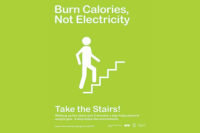Fifty one. That’s how many light bulbs I have in my house, I know because I counted them. Had someone asked me to guess prior to actually counting, I may have said 20 or maybe 25. Fifty one light bulbs, sitting in a big box on my countertop. A mixed assortment of halogens, compact fluorescents and incandescents, ranging between 18 to 100 watts each. And why, you are wondering, are all these light bulbs sitting in a box on my countertop? Let me explain...
A few years ago, being the Mr. Green Jeans that I am, I decided that I would do the right thing and replace as many incandescent light bulbs with compact fluorescents that I could. At the time, CFLs had really arrived—they were equivalent to just about any light bulb you wanted to replace, and much more energy efficient. I bought CFL floods, dimmable CFLs and garden-variety 60W incandescent equivalents. They were expensive, but I was committed to doing my part to conserve energy, and it was exciting! That excitement slowly morphed into something closer to tolerance as I learned to live with the CFLs that I installed. Their performance was spotty. At first, they seemed to work very well, but in time many of them started doing really annoying things like lagging for a few seconds when flipping the switch, or not really dimming but sort of just going from a lowish lighting level to a lower lighting level accompanied by a bug-zapper-sounding humming. Some simply just gave up and burned out long before the claimed lifespan. What was I to do?
While visiting a friend at his house, I noticed that his light bulbs looked a little strange not incandescent, not halogen, and not CFLs—they were LEDs. And they looked and worked fabulously. Still smarting over the money I shelled out for those crappy CFLs, I could only dream about one day swapping them out for something as nice as my friend’s LEDs. Until he told me he paid a mere $5.99 per 60W-equivalent bulb (9.5 watts), due to a newly offered, limited time utility district subsidy. It gets better: LEDs use about half the electricity as CFLs and they last six times longer (22.8 years). I was in.
What Took So Long?
I have known about LED lighting and its potential for many years. As great as they are, they were too dim and very expensive. That changed in 2008 when the Department of Energy announced the L prize—a competition to design ultra-efficient lighting to replace current lighting technology. In addition to being affordable, high quality and meeting minimum mass manufacturing requirements, the L price also required that each bulb meet the following performance criteria:
- Efficacy: 90 lumens per watt.
- Light Output: More than 900 lumens.
- Wattage: Less than 10 watts.
- Correlated Color Temperature: 2,700K – 3,000K.
- Form: Same lamp form as incandescent.
In 2011, Philips was awarded the first L prize for an LED bulb that represents a major technological leap forward for LED replacement lamps. Prior to Philips’ submission, no widely available products were near the L prize requirements for output and efficacy. The competition spawned a scramble among other manufacturers to develop something like Philips’ winning entry and today there are several products being sold that meet the L prize criteria.
Koomey’s Law and the Gravity Light
Research by Stanford University professor Jonathan Koomey reveals that since 1940, energy efficiency of computers has doubled about every one and a half years. This is sort of a parallel to Moore’s law which states that computers will double in performance every 18 months. This rapid increase in performance and reduction in energy use is what has finally brought us efficient LED bulbs. Predictions are that Koomey’s law will remain in effect for a century.
Ultra efficient LED bulbs have paved the way for what is one of the coolest inventions I have ever seen: The GravityLight. Invented by a British duo to bring electric light to impoverished communities throughout the world, the GravityLight is a small generator run by a hanging sack of rocks, which in turn powers an ultra-efficient LED bulb. A three second pull on the rope to raise the bag will power the light for up to 30 minutes. And because Koomey’s law is not limited to just light bulbs, this simple device is once day envisioned as something that can power many more electrical devices—cell phones, radios and even to charge batteries.
Conclusion
We are living in an unbelievable age of technological achievement. I spent $300 to light my entire house with LED bulbs that will last well beyond my final mortgage payment and save me thousands of dollars in electricity bills. A few years from now these same light bulbs may be half as much and twice as efficient. The mind boggles.





Report Abusive Comment